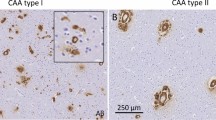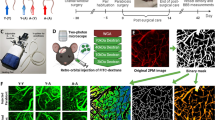Abstract
Alzheimer’s – disease is a progressive neurodegenerative disorder in which the accumulation of β‑amyloid and neurofibrillary tangles is a determining pathological sign. Activation of RAGE plays a decisive role in the production and aggregation of β-amyloid, formation of neurofibrillary tangles and degeneration of neurons. The aim of this work is to assess the influence of RAGE and its ligands—β-amyloid (Aβ1-42) on endothelial cells of cerebral microvascular in model blood-brain barrier (BBB) in vitro with experimental Alzheimer’s disease. Modeling of experimental Alzheimer’s disease in vitro caused a significant (P ≤ 0.05) increase expression of RAGE on endothelial cells and decrease in the transendothelial electric resistance (TEER) in both the static and dynamic models BBB. However, suppressed expression of RAGE led to a persistent and long-term increase value of TEER. In this case, the ligand RAGE-Ab1-42 caused reduced parameters of TEER. Alzheimer’s disease is accompanied by pathological changes in the expression of RAGE on endothelial cells, thereby leading to altered structural and functional integrity of the BBB. Blocking the RAGE expression in cerebral endothelial cells inhibits development of endothelial dysfunction and restores integrity of BBB impaired by the action of β-amyloid.




Similar content being viewed by others
REFERENCES
Arancio, O., Zhang, H.P., Chen, X., Lin, C., Trinchese, F., Puzzo, D., Liu, S., Hegde, A., Yan, F.S., Stern, A., Luddy, J.S., Lue, L.-F., Walker, D.G., Roher, A., Buttini, M., et al., RAGE potentiates abeta-induced perturbation of neuronal function in transgenic mice, EMBO J., 2004, vol. 23, p. 4096. https://doi.org/10.1038/sj.emboj.7600415
Bell, R.D., Sagare, A.P., Friedman, A.E., Bedi, G.S., Holtzman, D.M., Deane, R., and Zlokovic, B.V., Transport pathways for clearance of human Alzheimer’s amyloid beta-peptide and apolipoproteins E and J in the mouse central nervous system, J. Cereb. Blood Flow Metab., 2007, vol. 27, p. 909. https://doi.org/10.1038/sj.jcbfm.9600419
Bloom, G.S., Amyloid-β and tau: the trigger and bullet in Alzheimer disease pathogenesis, JAMA Neurol., 2014, vol. 71, p. 505. https://doi.org/10.1001/jamaneurol.2013.5847
Chen, Y.G., Research progress in the pathogenesis of Alzheimer’s disease, Chin. Med. J. (Engl)., 2018, vol. 131, p. 624. https://doi.org/10.4103/0366-6999.235112
Criscuolo, C., Fontebasso, V., Middei, S., Stazi, M., Ammassari-Teule, M., Yan, S.S., and Origlia, N., Entorhinal cortex dysfunction can be rescued by inhibition of microglial rage in an Alzheimer’s disease mouse model, Sci. Rep., 2017, vol. 7, p. 42370. https://doi.org/10.1038/srep42370
Deane, R., Wu, Z., and Zlokovic, B.V., RAGE (yin) versus LRP (yang) balance regulates Alzheimer amyloid beta-peptide clearance through transport across the blood-brain barrier, Stroke, 2004, vol. 35, p. 2628. https://doi.org/10.1161/01.STR.0000143452.85382.d1
Donahue, J.E., Flaherty, S.L., Johanson, C.E., Duncan, J.A., Silverberg, G.D., Miller, M.C., Tavares, R., Yang, W., Wu, Q., Sabo, E., Hovanesian, V., and Stopa, E.G., RAGE, LRP-1, and amyloid-beta protein in Alzheimer’s disease, Acta Neuropathol., 2006, vol. 112, p. 405. https://doi.org/10.1007/s00401-006-0115-3
Fang, F., Lue, L.-F., Yan, S., Xu, H., Luddy, J.S., Chen, D., Walker, D.G., Stern, D.M., Yan, S., Schmidt, A.M., Chen, J.X., and Yan, S.S., RAGE-dependent signaling in microglia contributes to neuroinflammation, abeta accumulation, and impaired learning/memory in a mouse model of Alzheimer’s disease, FASEB J., 2010, vol. 24, p. 1043. https://doi.org/10.1096/fj.09-139634
García-Cabezas, M.Á., John, Y.J., Barbas, H., and Zikopoulos, B., Distinction of neurons, glia and endothelial cells in the cerebral cortex: an algorithm based on cytological features, Front. Neuroanat., 2016, vol. 10, p. 107. https://doi.org/10.3389/fnana.2016.00107
Gool, B.V., Storck, S.E., Reekmans, S.M., Lechat, B., Gordts, P.L.S.M., Pradier, L., Pietrzik, C.U., and Roebroek, A.J.M., LRP1 has a predominant role in production over clearance of Aβ in a mouse model of Alzheimer’s disease, Mol. Neurobiol., 2019, vol. 56, p. 7234. https://doi.org/10.1007/s12035-019-1594-2
Goustard-Langelier, B., Koch, M., Lavialle, M., and Heberden, C., Rat neural stem cell proliferation and differentiation are durably altered by the in utero polyunsaturated fatty acid supply, J. Nutr. Biochem., 2012, vol. 24, p. 380. https://doi.org/10.1016/j.jnutbio.2012.08.001
Guo, Y.-X., He, L.-Y., Zhang, M., Wang, F., Liu, F., and Peng, W.-X., 1,25-Dihydroxyvitamin D3 regulates expression of LRP1 and RAGE in vitro and in vivo, enhancing Aβ1-40 brain-to-blood efflux and peripheral uptake transport, Neuroscience, 2016, vol. 322, p. 28. https://doi.org/10.1016/j.neuroscience.2016.01.041
Jedlitschky, G., Grube, M., Mosyagin, I., Kroemer, H.K., and Vogelgesang, S., Targeting CNS transporters for treatment of neurodegenerative diseases, Curr. Pharm. Des., 2014, vol. 20, p. 1523. https://doi.org/10.2174/13816128113199990460
Jeong, S., Molecular and cellular basis of neurodegeneration in Alzheimer’s disease, Mol. Cells, 2017, vol. 40, p. 613. https://doi.org/10.14348/molcells.2017.0096
Kook, S.-Y., Hong, H.S., Moon, M., Ha, C.M., Chang, S., and Mook-Jung, I., Aβ1−42-RAGE interaction disrupts tight junctions of the blood-brain barrier via Ca2+-calcineurin signaling, J. Neurosci., 2012, vol. 32, p. 8845. https://doi.org/10.1523/JNEUROSCI.6102-11.2012
Liu, Y., Xue, Q., Tang, Q., Hou, M., Qi, H., Chen, G., Chen, W., Zhang, J., Chen, Y., and Xu, X., A simple method for isolating and culturing the rat brain microvascular endothelial cells, Microvasc. Res., 2013, vol. 90, p. 199. https://doi.org/10.1016/j.mvr.2013.08.004
Lue, L.F., Walker, D.G., Brachova, L., Beach, T.G., Rogers, J., Schmidt, A.M., Stern, D.M., and Yan, S.D., Involvement of microglial receptor for advanced glycation endproducts (RAGE) in Alzheimer’s disease: identification of a cellular activation mechanism, Exp. Neurol., 2001, vol. 1, p. 29. https://doi.org/10.1006/exnr.2001.7732
Miller, M.C., Tavares, R., Johanson, C.E., Hovanesian, V., Donahue, J.E., Gonzalez, L., Silverberg, G.D., and Stopa, E.G., Hippocampal RAGE immunoreactivity in early and advanced Alzheimer’s disease, Brain Res., 2008, vol. 1230, p. 273. https://doi.org/10.1016/j.brainres.2008.06.124
Mohamed, L.A., Zhu, H., Mousa, Y.M., Wang, E., Qiu, W.Q., and Kaddoumi, A., Amylin enhances amyloid‑β peptide brain to blood efflux across the blood-brain barrier, J. Alzheimers Dis., 2017, vol. 56, p. 1087. https://doi.org/10.3233/JAD-160800
Morgun, A.V., Kuvacheva, N.V., Komleva, Yu.K., Kutishcheva, I.A., Okuneva, O.S., Drobushevskaya, A.I., Khilazheva, E.D., Cherepanov, S.M., and Salmina, A.B., Differentiation of rat brain embryonic progenitor cells into astrocytes and neurons, Sib. Med. Obozr., 2013, no. 6, p. 9.
Nan, K., Han, Y., Fang, Q., Huang, C., Yu, L., Ge, W., Xiang, F., Tao, Y.-X., Cao, H., and Li, J., HMGB1 gene silencing inhibits neuroinflammation via down-regulation of NF-κB signaling in primary hippocampal neurons induced by Aβ 25-35, Int. Immunopharmacol., 2019, vol. 67, p. 294. https://doi.org/10.1016/j.intimp.2018.12.027
Oh, S., Son, M., Choi, J., Lee, S., and Byun, K., SRAGE prolonged stem cell survival and suppressed RAGE-related inflammatory cell and T lymphocyte accumulations in an Alzheimer’s disease model, Biochem. Biophys. Res. Commun., 2018, vol. 495, p. 807. https://doi.org/10.1016/j.bbrc.2017.11.035
Origlia, N., Arancio, O., Domenici, L., and Yan, S.S., beta-Amyloid and synaptic dysfunction: the role of RAGE affiliations expand, Expert Rev. Neurother., 2009, vol. 9, p. 1635. https://doi.org/10.1586/ern.09.107
Qosa, H., Abuasal, B.S., Romero, I.A., Weksler, B., Couraud, P.-O., Keller, J.N., and Kaddoumi, A., Differences in amyloid-β clearance across mouse and human blood-brain barrier models: kinetic analysis and mechanistic modeling, Neuropharmacology, 2014, vol. 79, p. 668. https://doi.org/10.1016/j.neuropharm.2014.01.023
Sengupta, U., Nilson, A.N., and Kayed, R., The role of amyloid-β oligomers in toxicity, propagation, and immunotherapy, EBioMedicine, 2016, vol. 6, p. 42. https://doi.org/10.1016/j.ebiom.2016.03.035
Takeuchi, M., Sato, T., Takino, J., Kobayashi, Y., Furuno, S., Kikuchi, S., and Yamagishi, S., Diagnostic utility of serum or cerebrospinal fluid levels of toxic advanced glycation end-products (TAGE) in early detection of Alzheimer’s disease, Med. Hypotheses, 2007, vol. 69, p. 1358. https://doi.org/10.1016/j.mehy.2006.12.017
Tóbon-Velasco, J.C., Cuevas, E., and Torres-Ramos, M.A., Receptor for ages (rage) as mediator of NF-kb pathway activation in neuroinflammation and oxidative stress, CNS Neurol. Disord. Drug Targets, 2014, vol. 13, p. 1615. https://doi.org/10.2174/1871527313666140806144831
Ueno, M., Chiba, Y., Matsumoto, K., Nakagawa, T., and Miyanaka, H., Clearance of beta-amyloid in the brain, Curr. Med. Chem., 2014, vol. 21, p. 4085. https://doi.org/10.2174/0929867321666141011194256
Uspenskaya, Yu.A., Komleva, Yu.K., Pozhilenkova, E.A., Salmin, V.V., Lopatina, O.L., Fursov, A.A., Lavrent’ev, P.V., Belova, O.A., and Salmina, A.B., RAGE protein ligands: role in cellular communication and inflammation pathogenesis, Vestn. Russ. Akad. Med. Nauk, 2015, vol. 70, no. 6, p. 704.
Wan, W., Cao, L., Liu, L., Zhang, C., Kalionis, B., Tai, X., Li, Y., and Xia, S., Aβ(1–42) oligomer-induced leakage in an in vitro blood-brain barrier model is associated with up-regulation of RAGE and metalloproteinases, and down-regulation of tight junction scaffold proteins, J. Neurochem., 2015, vol. 134, p. 382. https://doi.org/10.1111/jnc.13122
Welikovitch, L.A., Carmo, S.D., Maglóczky, Z., Szocsics, P., Lőke, J., Freund, T., and Cuello, A.C., Evidence of intraneuronal Aβ accumulation preceding tau pathology in the entorhinal cortex, Acta Neuropathol., 2018, vol. 136, p. 901. https://doi.org/10.1007/s00401-018-1922-z
Yamada, K., Hashimoto, T., Yabuki, C., Nagae, Y., Tachikawa, M., Strickland, D.K., Liu, Q., Bu, G., Basak, J.M., Holtzman, D.M., Ohtsuki, S., Terasaki, T., and Iwatsubo, T., The low density lipoprotein receptor-related protein 1 mediates uptake of amyloid beta peptides in an in vitro model of the blood-brain barrier cells, J. Biol. Chem., 2008, vol. 283, p. 34554. https://doi.org/10.1074/jbc.M801487200
Yamamoto, Y., Liang, M., Munesue, S., Deguchi, K., Harashima, A., Furuhara, K., Yuhi, T., Zhong, J., Akther, S., Goto, H., Eguchi, Y., Kitao, Y., Hori, O., Shiraishi, Y., and Ozaki, N.et, al., Vascular RAGE transports oxytocin into the brain to elicit its maternal bonding behaviour in mice, Commun. Biol., 2019, vol. 2, p. 76. https://doi.org/10.1038/s42003-019-0325-6
Yu, Q.C., Song, W., Wang, D., and Zeng, Y.A., Identification of blood vascular endothelial stem cells by the expression of protein C receptor, Cell Res., 2016, vol. 26, p. 1079. https://doi.org/10.1038/cr.2016.85
Funding
This work was financially supported by the Program of the President of the Russian Federation for State Support of Leading Scientific Schools of the Russian Federation (S-S-2547.2020.7).
Author information
Authors and Affiliations
Corresponding author
Ethics declarations
Conflict of interest. The authors declare no obvious and potential conflicts of interest related to the publication of this article.
Statement on the welfare of animals. The work with animals was carried out in compliance with the principles of humanity, which are set out in the European Community Directive (2010/63/EC). The experiments were carried out with the permission of the Bioethical Commission for Working with Animals at the Local Ethics Committee of the Krasnoyarsk State Medical University named after prof. V.F. Voino-Yasenetsky (Excerpt from the protocol no. 7 dated February 11, 2019).
Additional information
Abbreviations: AD—Alzheimer’s disease; BBB—blood-brain barrier; TEER—trans endothelial electrical resistance; LRP1— low density lipoprotein receptor-related protein 1 (protein 1, similar to the low density lipoprotein receptor); Aβ1-42—β-amyloid.
Rights and permissions
About this article
Cite this article
Gorina, Y.V., Osipova, E.D., Morgun, A.V. et al. Assessment of the Level of Rage in Cells Blood-Brain Barrier in Experimental Alzheimer’s Disease. Cell Tiss. Biol. 15, 280–286 (2021). https://doi.org/10.1134/S1990519X21030032
Received:
Revised:
Accepted:
Published:
Issue Date:
DOI: https://doi.org/10.1134/S1990519X21030032




